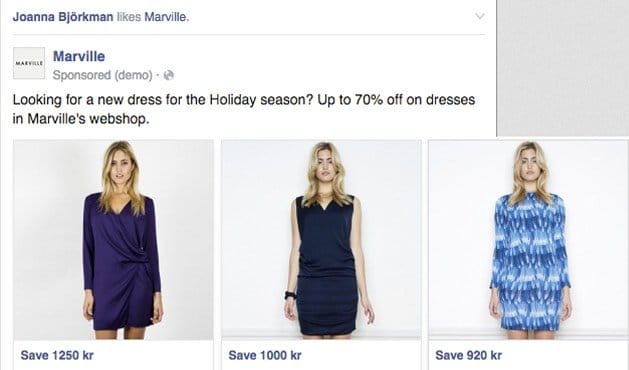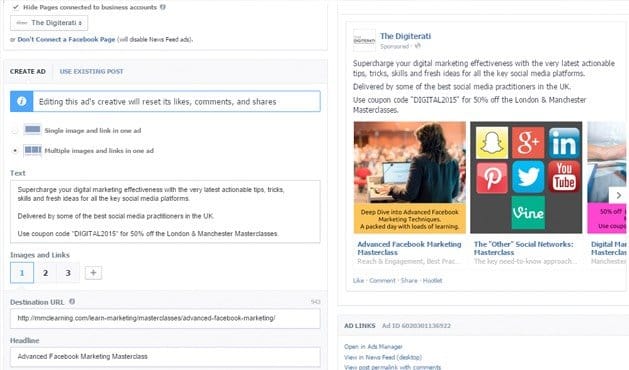 Written by ContentPowered.com
Written by ContentPowered.com
About a month ago, Facebook released a new type of ad you can use. These are called dynamic product ads, or dynamic multi-product ad units. At the time of their announcement, they were only available through the ads API, with a Power Editor implementation forthcoming. That implementation exists now, and it’s made these ads very much worth looking into. So what are these ads, how do they work, and why should you give them a serious look?
Static Multi-Product Ads
Multi-product ads are a relatively new feature in the Facebook ads pantheon, and they’re really quite good. The concept is simple; instead of a single image for a single product in a news feed ad, the image is slightly offset and a second image is just peeking around the corner. This is part of a carousel of several ad images, each for a different product.
These ads can have up to five different products in them if you’re using the Power Editor. If you’re using the ads API directly, you can push in up to ten. That’s a lot of unique creative copy within a single ad! Given that these work with both desktop and mobile news feed ads, that’s a lot of variation within a single ad.
The promoted use by Facebook is a product ad. The idea is that you offer a selection of products in a given ad, rather than just one fixed product, so you can hit a range of interests amongst a single demographic in a single ad. This way you don’t have to double or triple or quintuple-expose your users to ads for different products; you can bundle them all into one more compelling package.
That said, you’re not strictly limited to products with these ads. You can, for example, bundle up a handful of similarly-themed blog posts to promote in one ad unit.
For the moment, there are only two objectives you can use with these ads; website clicks and website conversions. If you’re not using one of these objectives, you won’t see the ad type. If you’re using it properly, when you go to create an ad, you will see the default “single image and link in one ad” and a variation “multiple images and links in one ad.” This second option is the multi-product ad. For a more detailed explanation of how to create one, check out this excellent post by Jon Loomer.
The Benefits of Multi-Product Ads
These multi-product ads are proving to be very useful for Facebook marketers. Loomer has reported seeing website clicks come in for around half the cost of normal single-product ads. Others report similar cost reductions for great results.
There’s only one drawback to multi-product ads, and that’s the creative. When you pick a selection of 5-10 products to put into an ad, you’re guessing that at least one of those products – or blog posts, or whatever – is going to be attractive to your target audience. If you guess wrong, that product is a waste of space. If the first 2-3 products aren’t the attractive ones, you’ll end up with an ad with a bunch of creative that no one scrolls sideways to see. This is where dynamic multi-product ads come in.
Where Dynamic Ads Live
Dynamic product ads are sort of a cross between traditional multi-product ads and retargeting ads. What they do is adapt themselves to the audience viewing them, via tracking pixels.
Prior to the introduction of these dynamic ads, if you wanted to run retargeting, you would need to create a custom audience based on the people who visit certain pages on your site, as tracked by the Facebook Tracking Pixel. Unfortunately, if you wanted to track at the product level, you would have to create a pixel for each product. If you have hundreds or thousands of products, you can see how unfeasible this becomes.
Dynamic ads use a new type of tracking pixel, called the Dynamic Website Custom Audience Pixel. You put this pixel on every product page you want tracked, and Facebook monitors them all. When a user visits one, Facebook notes the product ID of the product in question. If you have 100 products, and a user visits 7 of them, that pixel will report a custom audience of that person who has visited those 7 products.
Of course, Facebook doesn’t create individual custom audiences for every possible variation; that would be insane. They just use an overall dynamic custom audience.
Creating and Using a Dynamic Ad
Create a normal multi-product ad as usual, possibly using Loomer’s instructions as linked above. He covers it better than I could. The only difference is that you use a Dynamic Ad Template instead of the normal ad template. You create a single ad with a single set of copy, and the dynamic audience tracking automatically populates the product spaces with data from your website.
A user who visits your website and sees a few products will then visit Facebook and see those same products advertised in your ad. They’ll think you have a wonderful grasp on what they like, because you guessed exactly what they were browsing. In reality, Facebook tracked them and shows them what they wanted to see.
You do need to make sure your product pages all have unique product IDs and that the information you want to display in a dynamic product ad is available. If you’re hiding the price of your products behind a shopping cart or something, you can’t display it in your ads. Facebook needs to be able to pull the data.
One amazing benefit of the dynamic product ads is automatic availability tracking. If you have a limited supply of a given product and it sells out, normally you would need to suspend the ad that promotes it. Otherwise, users will click through but won’t be able to convert, which is a big no-no in marketing. With dynamic ads, Facebook tracks availability. When you run out of a given product – as long as your site reflects that lack of availability – that product will disappear from the dynamic product ad rotation. When you get more in stock and update your site, your ad automatically updates as well. No intervention on your part is necessary.
Once you’ve implemented a few of these dynamic ads, you’ll honestly wonder how you lived without them. By now, they should be available in the Power Editor for most people, so you can get started immediately.

